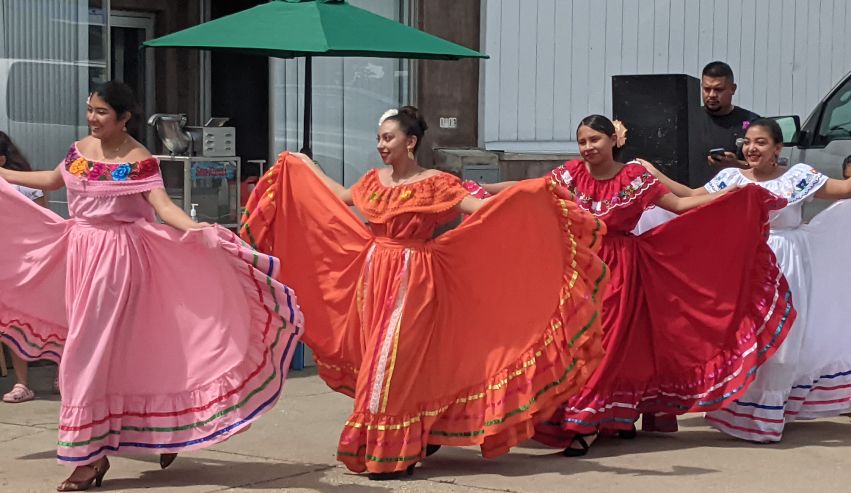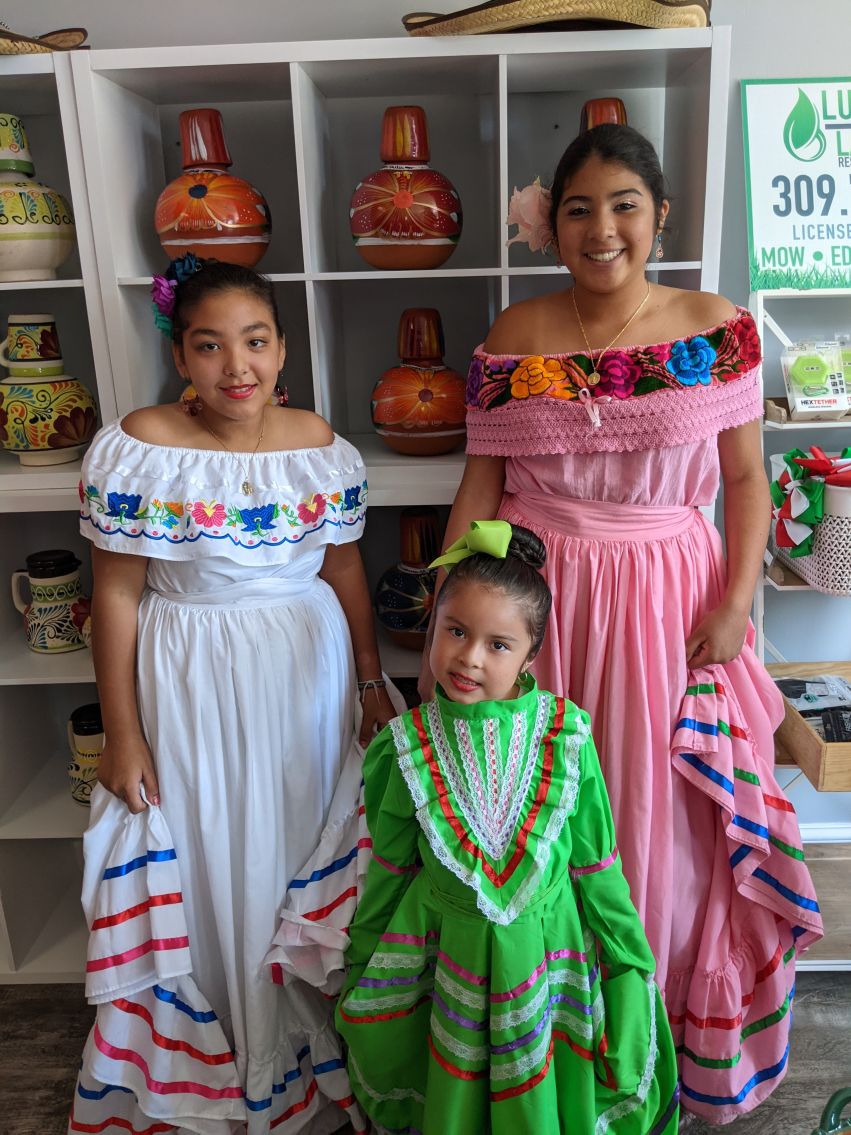
One of the most colorful and liveliest places to be in central Illinois is wherever the Peoria Folklore Ballet is performing. A rainbow of brilliant reds, vibrant oranges, blazing yellows, sharp whites and rosy pinks swirls across the dance floor as girls, ages three to 14, spin in dresses that wave in a billowing tide to the equally spirited brass, string and percussion music.
The rippling of skirts never ceases as the dancers punctuate every beat with nimble steps, in and out of one formation to the next, their movements animated by an enthusiasm that is infectious to anyone watching. Buoyed by a cheering crowd, the dancers meet face to face fleetingly amidst spins, bends and dips before surging outward again—the tide of rainbow skirts stills only as the last note of music swells.
The woman behind this festive scene is Peorian Maria Miranda, who goes by the nickname “Chayo.” Miranda is the founder of Peoria Folklore Ballet (PFB), in which local Latina girls learn about traditional Mexican folk dance, their cultural heritage and values like camaraderie, belonging and community. The Peoria Folklore Ballet, known in Spanish as “Las Guarecitas,” has been on the stage for nearly nine years—and they are just getting started.
A Whirlwind of Activity
After a hiatus due to COVID, PFB have recently begun practicing and performing again. Watching the dancers, Miranda beams like a proud mother to this group of girls who have known her most of their lives. Sometimes she gets the chills, she explains, just “listening to the music and looking at them dancing and being so happy.” The girls’ parents are equally proud. “It’s just a very, very beautiful feeling,” Miranda reflects. “Our dance group pulls the Hispanic community together here.”
Miranda leads by example in this small community—as well as the larger community of central Illinois, which she has called home for many years. Valerie Smith, her co-worker at Morton Junior High School, admires Miranda’s can-do philosophy. “When she wants to see good things happen in the community, she helps make them happen,” Smith observes. Indeed, Miranda brings a passionate appreciation for Mexican culture to all she does.
And she does a lot. It’s back-to-school time, and in addition to getting her own sons ready for the new school year under today’s unusual circumstances, Miranda also returned to her role as an in-school healthcare provider. And since August, she has assumed another professional title: business owner. The grand opening of Miranda’s Bella Boutique on Prospect Road in Peoria was met with the actual fanfare of an eight-piece band. Miranda’s new shop has the feel of an informal community meeting space, as well as a store. They carry imports that Latinx families might consider staples—not food so much as household goods, small appliances, and various toys and candies that are not widely available in the United States. There’s beautiful pottery, handmade shoes and even linens.
Like most things Miranda does, the boutique is a community-wide effort. The clerk behind the cash register is her goddaughter. Many of the shoppers, from kids clamoring for fidget toys to adults scouting for wide-brimmed hats, are people the Miranda family know well, who are eager to support her new business. And the parking lot of her store is where Peoria Folklore Ballet practices. Because this kind of dance is typically held outdoors for festivals and celebrations, the girls rehearse onsite—though Miranda would like to find a suitable indoor venue so they can practice all year round.
These outdoor practices have prepared the girls to perform at all kinds of events around the city, at schools, libraries, churches and elsewhere. They’ve danced at festivals on the riverfront, and each year they perform at St. Mary’s Cathedral for the Virgin of Guadalupe celebration, which Miranda calls “an exciting moment when people get out their cameras, ready to videotape and take photos… and the community support is amazing.” Miranda points out that Las Guarecitas plays a key role in keeping Hispanic culture alive and thriving locally. Not surprisingly, her efforts have begun to garner attention—even at the international level.

Shared Cultures
On September 1, 2021, Mexican diplomat Reyna Torres Mendivil toured Peoria and spoke to the importance of community-grown heritage groups like Peoria Folklore Ballet. Ambassador Torres met with city officials, business leaders and addressed students at Bradley University, where she highlighted the crucial role that binationalism plays among Mexican Americans and Mexicans living in the United States.
While the concept is a simple one, binationalism was part of a larger pivot by the Mexican government in realizing it is both possible and beneficial for people of Mexican origin living in the U.S. to continue to develop both their American and Mexican identities—rather than expect people to acculturate entirely to their new home and leave their previous identity behind. “We changed our point of view a decade ago,” Ambassador Torres noted in her public remarks. “For instance, we changed to allow dual citizenship. And I think that’s beautiful because it opens up a world of opportunities… so they have no hesitation about their identity.”
 This worldview is especially important to young people growing up here in the U.S. “We need to invest in the next generation,” Ambassador Torres advises. And that is exactly what Maria Miranda is doing in building groups like Peoria Folklore Ballet: investing in growing binational and bicultural identities among the next generation, right here in central Illinois.
This worldview is especially important to young people growing up here in the U.S. “We need to invest in the next generation,” Ambassador Torres advises. And that is exactly what Maria Miranda is doing in building groups like Peoria Folklore Ballet: investing in growing binational and bicultural identities among the next generation, right here in central Illinois.
For example, what dancer Joanna Avila, 14, a freshman at Peoria Central High, likes about being in the group is not only hanging with friends, but also celebrating “our history and culture in performances at the riverfront and festivals.” Evelyn Avila, 12, a seventh grader at Lincoln Middle School, enjoys that she gets to move a lot through dance, which she’s been doing in Las Guarecitas since age four.
At 14, dancer Juliana Ocampo is among the older girls in the group and has been with PFB since she was six or seven. Some girls in the group begin as early as three years old. Several of them are cousins. Some are no relation, yet there is a feeling of family that Miranda cultivates among them all.
Ocampo loves that each girl gets to pick their own dress and its color, which are handmade in Mexico. She chose a beautiful, vibrant pink with embroidered flowers and fruits in the style of a specific region of Mexico—a state called Jalisco. Initially the group’s costumes reflected the style of Michoacán, where Miranda is from: matching white tops with tapestry skirts embroidered in red thread in the style of the indigenous people of central Mexico. The skirts are made of six feet of heavy material, and the dancers manipulate them almost the entire time they are on stage. They get hot very quickly, and Miranda is sure to have water on hand as soon as they finish.
In spite of the heat, Ocampo appreciates the way the group helps her celebrate her heritage. “It’s important to show off your culture,” she explains. “It’s fun dancing with friends and family. We’re a community as well as actual relatives.” That is a key observation to make so early in life—a lesson that Las Guarecitas imparts at an early age to its young participants.
Commitment to Community
Like many teens, Juliana Ocampo also plays sports. She is on the soccer team at Richwoods High School, where she is now a freshman, as well as a traveling team. She also has strong civic commitments, such as Junior ROTC, which does not involve preparing children for the military so much as preparing them to become better citizens by teaching core tenets such as leadership, character and community service.
It’s probably no coincidence that students from Peoria Folklore Ballet have a civic commitment such as this. Love of country, family and community are at the heart of the way Miranda leads the group. She doesn’t charge families to participate, aside from paying for their costumes, and she provides snacks at every practice. She would like to see the group continue its growth, and perhaps even hire a trained folkloric dance teacher. But the ways a group like this can grow are often unpredictable.
Last year, Miranda posted on the PFB Facebook page an idea she had to celebrate Mexican Independence Day: a car caravan like those that became popular during the pandemic to allow for socially distant celebrations. Expecting just her dance families and a few friends to participate, she was astonished to find 170 cars at the event on September 16, 2020—which speaks yet again to the genuine connections forged by groups like Peoria Folklore Ballet and leaders like Maria “Chayo” Miranda—and the many ways in which they add color, music and life to our community. PM
This article was sponsored by Big Picture Initiative. Learn more at bigpicturepeoria.org. To learn more about Peoria Folklore Ballet, find them on Facebook @PeoriaFolkloreBallet or call (309) 349-4636.
- Log in to post comments

